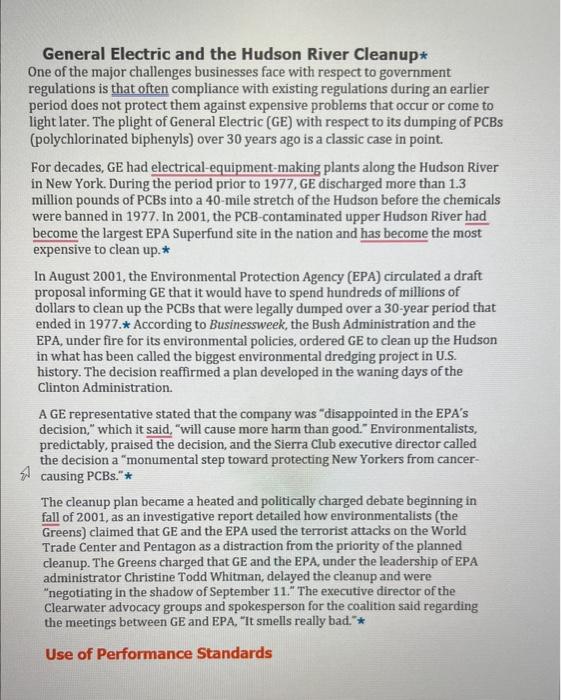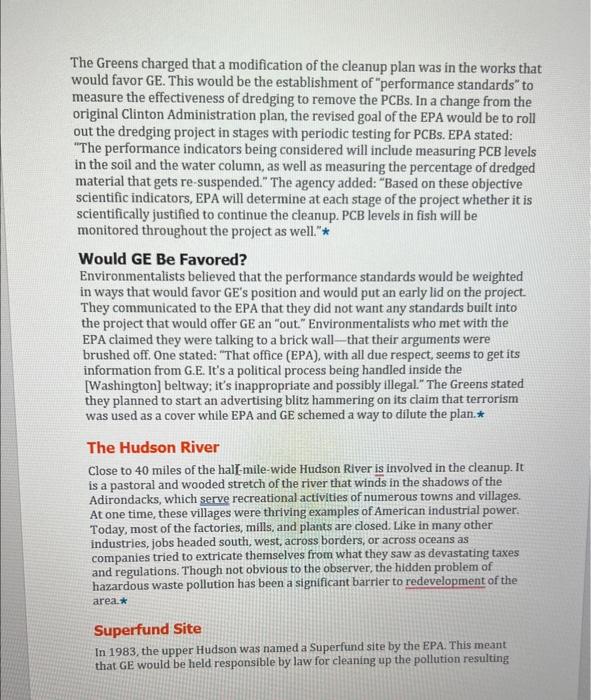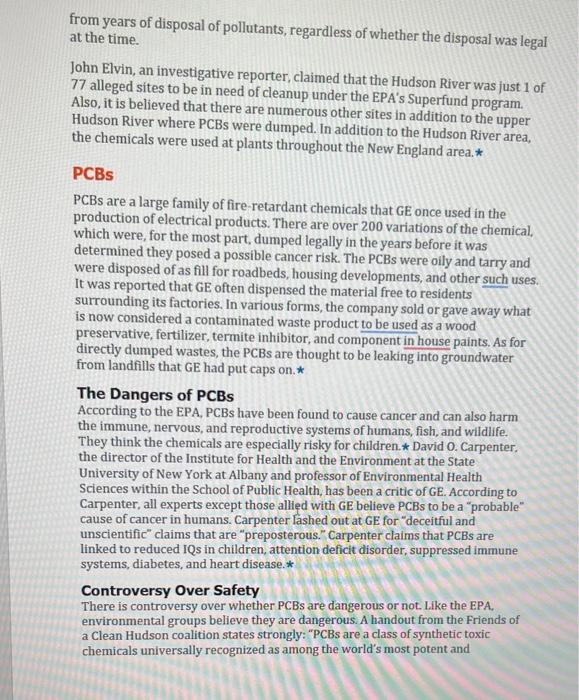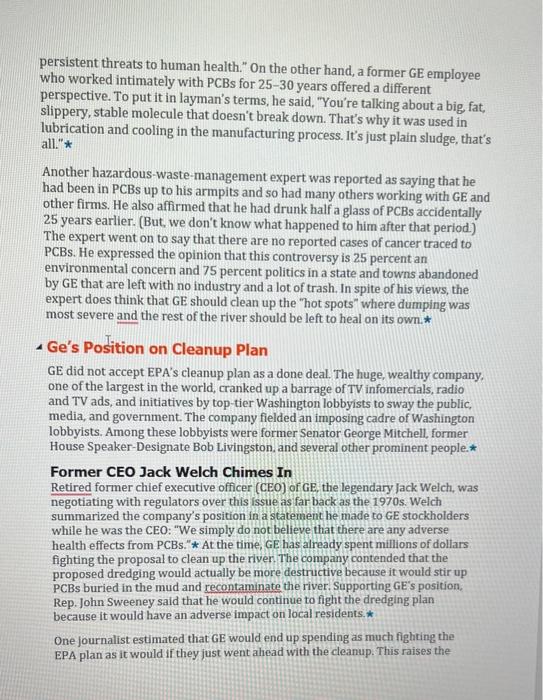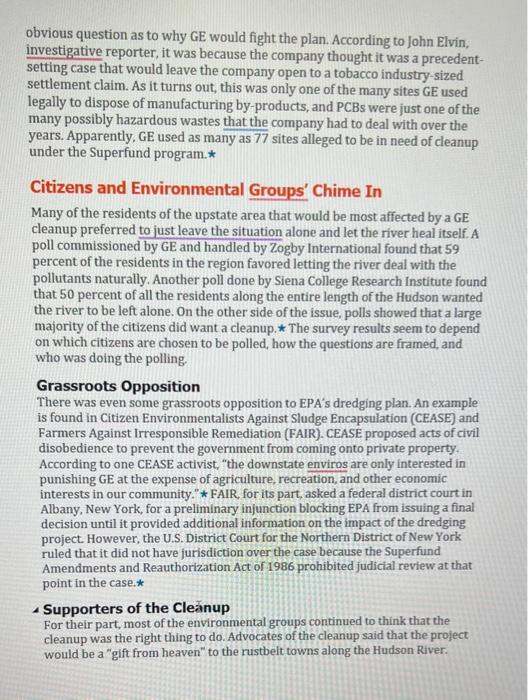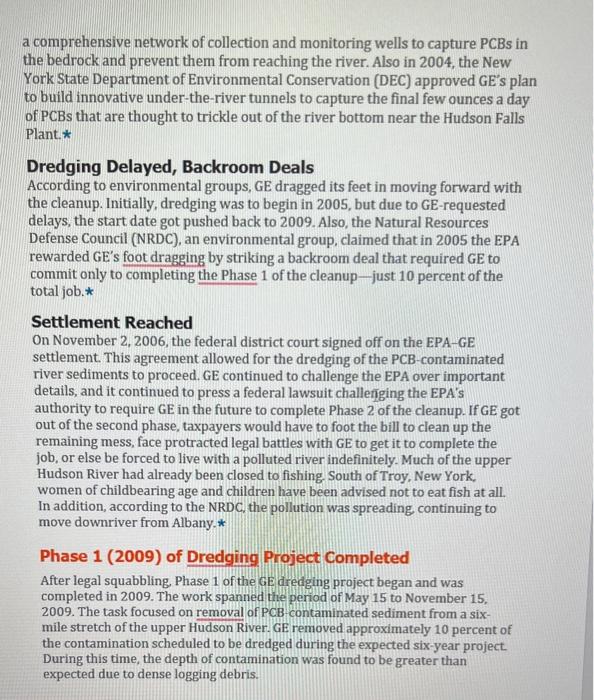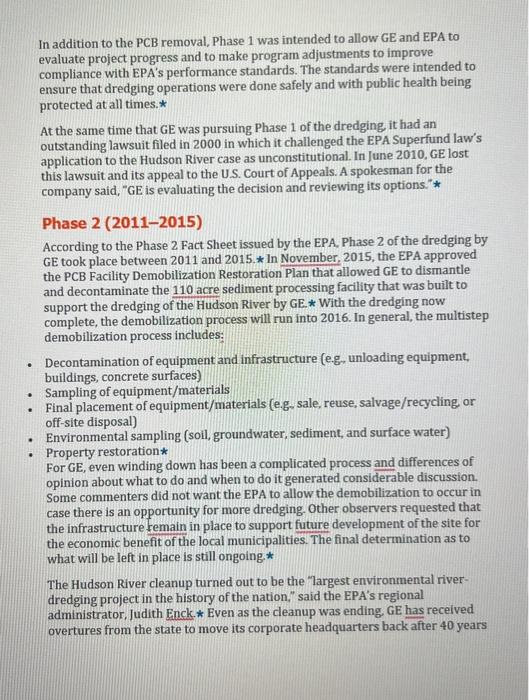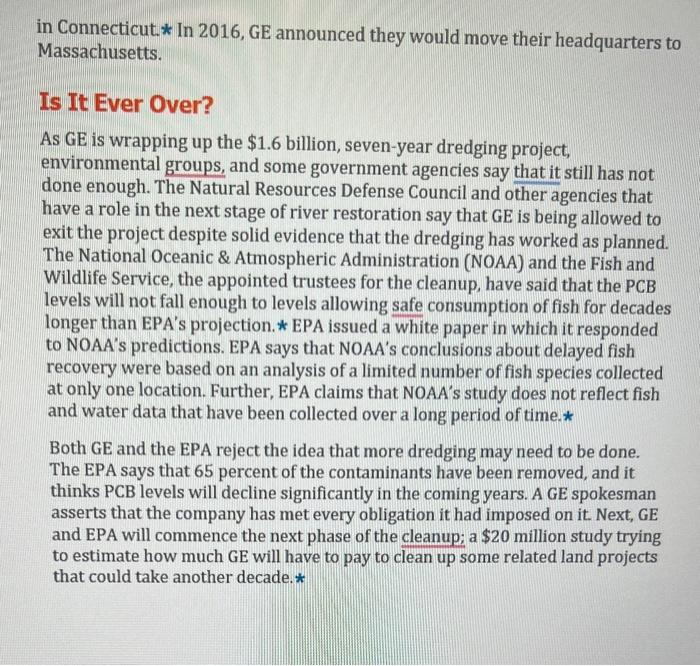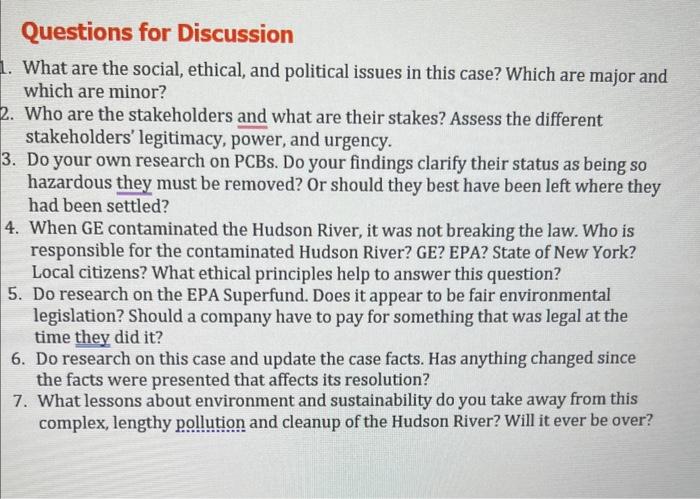General Electric and the Hudson River Cleanup * One of the major challenges businesses face with respect to government regulations is that often compliance with existing regulations during an earlier period does not protect them against expensive problems that occur or come to light later. The plight of General Electric (GE) with respect to its dumping of PCBs (polychlorinated biphenyls) over 30 years ago is a classic case in point. For decades, GE had electrical-equipment-making plants along the Hudson River in New York. During the period prior to 1977, GE discharged more than 1.3 million pounds of PCBs into a 40 -mile stretch of the Hudson before the chemicals were banned in 1977. In 2001, the PCB-contaminated upper Hudson River had become the largest EPA Superfund site in the nation and has become the most expensive to clean up.* In August 2001, the Environmental Protection Agency (EPA) circulated a draft proposal informing GE that it would have to spend hundreds of millions of dollars to clean up the PCBs that were legally dumped over a 30-year period that ended in 1977. According to Businessweek, the Bush Administration and the EPA, under fire for its environmental policies, ordered GE to clean up the Hudson in what has been called the biggest environmental dredging project in U.S. history. The decision reaffirmed a plan developed in the waning days of the Clinton Administration. A GE representative stated that the company was "disappointed in the EPA's decision," which it said, "will cause more harm than good." Environmentalists, predictably, praised the decision, and the Sierra Club executive director called the decision a "monumental step toward protecting New Yorkers from cancercausing PCBs." * The cleanup plan became a heated and politically charged debate beginning in fall of 2001, as an investigative report detailed how environmentalists (the Greens) claimed that GE and the EPA used the terrorist attacks on the World Trade Center and Pentagon as a distraction from the priority of the planned cleanup. The Greens charged that GE and the EPA, under the leadership of EPA administrator Christine Todd Whitman, delayed the cleanup and were "negotiating in the shadow of September 11." The executive director of the Clearwater advocacy groups and spokesperson for the coalition said regarding the meetings between GE and EPA, "It smells really bad." Use of Performance Standards The Greens charged that a modification of the cleanup plan was in the works that would favor GE. This would be the establishment of "performance standards" to measure the effectiveness of dredging to remove the PCBs. In a change from the original Clinton Administration plan, the revised goal of the EPA would be to roll out the dredging project in stages with periodic testing for PCBs. EPA stated: "The performance indicators being considered will include measuring PCB levels in the soil and the water column, as well as measuring the percentage of dredged material that gets re-suspended." The agency added: "Based on these objective scientific indicators, EPA will determine at each stage of the project whether it is scientifically justified to continue the cleanup. PCB levels in fish will be monitored throughout the project as well." * Would GE Be Favored? Environmentalists believed that the performance standards would be weighted in ways that would favor GE's position and would put an early lid on the project. They communicated to the EPA that they did not want any standards built into the project that would offer GE an "out." Environmentalists who met with the EPA claimed they were talking to a brick wall-that their arguments were brushed off. One stated: "That office (EPA), with all due respect, seems to get its information from G.E. It's a political process being handled inside the [Washington] beltway; it's inappropriate and possibly illegal." The Greens stated they planned to start an advertising blitz hammering on its claim that terrorism was used as a cover while EPA and GE schemed a way to dilute the plan.t The Hudson River Close to 40 miles of the half-mile-wide Hudson River is involved in the cleanup. It is a pastoral and wooded stretch of the river that winds in the shadows of the Adirondacks, which serve recreational activities of numerous towns and villages. At one time, these villages were thriving examples of American industrial power: Today, most of the factories, mills, and plants are closed. Like in many other industries, jobs headed south, west, across borders, or across oceans as companies tried to extricate themselves from what they saw as devastating taxes and regulations. Though not obvious to the observer, the hidden problem of hazardous waste pollution has been a significant barrier to redevelopment of the area * Superfund Site In 1983, the upper Hudson was named a Superfund site by the EPA. This meant that GE would be held responsible by law for cleaning up the pollution resulting from years of disposal of pollutants, regardless of whether the disposal was legal at the time. John Elvin, an investigative reporter, claimed that the Hudson River was just 1 of 77 alleged sites to be in need of cleanup under the EPA's Superfund program. Also, it is believed that there are numerous other sites in addition to the upper Hudson River where PCBs were dumped. In addition to the Hudson River area, the chemicals were used at plants throughout the New England area.* PCBs PCBs are a large family of fire-retardant chemicals that GE once used in the production of electrical products. There are over 200 variations of the chemical, which were, for the most part, dumped legally in the years before it was determined they posed a possible cancer risk. The PCBs were oily and tarry and were disposed of as fill for roadbeds, housing developments, and other such uses. It was reported that GE often dispensed the material free to residents surrounding its factories. In various forms, the company sold or gave away what is now considered a contaminated waste product to be used as a wood preservative, fertilizer, termite inhibitor, and component in house paints. As for directly dumped wastes, the PCBs are thought to be leaking into groundwater from landfills that GE had put caps on. * The Dangers of PCBs According to the EPA, PCBs have been found to cause cancer and can also harm the immune, nervous, and reproductive systems of humans, fish, and wildilfe. They think the chemicals are especially risky for children. David 0 . Carpenter. the director of the Institute for Health and the Environment at the State University of New York at Albany and professor of Environmental Health Sciences within the School of Public Health, has been a critic of GE. According to Carpenter, all experts except those allied with GE believe PCBs to be a "probable" cause of cancer in humans. Carpenter lashed out at GE for "deceitful and unscientific" claims that are "preposterous." Carpenter claims that PCBs are linked to reduced IQs in children, attention deficit disorder, suppressed immune systems, diabetes, and heart disease. * Controversy Over Safety There is controversy over whether PCBs are dangerous or not. Like the EPA. environmental groups believe they are dangerous. A handout from the Friends of a Clean Hudson coalition states strongly: "PCBs are a class of synthetic toxic chemicals universally recognized as among the world's most potent and persistent threats to human health." On the other hand, a former GE employee who worked intimately with PCBs for 25-30 years offered a different perspective. To put it in layman's terms, he said, "You're talking about a big, fat, slippery, stable molecule that doesn't break down. That's why it was used in lubrication and cooling in the manufacturing process. It's just plain sludge, that's all."* Another hazardous-waste-management expert was reported as saying that he had been in PCBs up to his armpits and so had many others working with GE and other firms. He also affirmed that he had drunk half a glass of PCBs accidentally 25 years earlier. (But, we don't know what happened to him after that period.) The expert went on to say that there are no reported cases of cancer traced to PCBs. He expressed the opinion that this controversy is 25 percent an environmental concern and 75 percent politics in a state and towns abandoned by GE that are left with no industry and a lot of trash. In spite of his views, the expert does think that GE should clean up the "hot spots" where dumping was most severe and the rest of the river should be left to heal on its own.* Ge's Position on Cleanup Plan GE did not accept EPA's cleanup plan as a done deal. The huge, wealthy company. one of the largest in the world, cranked up a barrage of TV infomercials, radio and TV ads, and initiatives by top-tier Washington lobbyists to sway the public, media, and government. The company fielded an imposing cadre of Washington lobbyists. Among these lobbyists were former Senator George Mitchell, former House Speaker-Designate Bob Livingston, and several other prominent people. * Former CEO Jack Welch Chimes In Retired former chief executive officer (CEO) of GE, the legendary Jack Welch, was negotiating with regulators over this issue as far back as the 1970 s. Welch summarized the company's position in a statement he made to GE stockholders while he was the CEO: "We simply do not believe that there are any adverse health effects from PCBs." At the time, GE has already spent millions of dollars fighting the proposal to clean up the river. The company contended that the proposed dredging would actually be more destructive because it would stir up PCBs buried in the mud and recontaminate the river. Supporting GE's position, Rep. John Sweeney said that he would continue to fight the dredging plan because it would have an adverse impact on local residents * One journalist estimated that GE would end up spending as much fighting the EPA plan as it would if they just went ahead with the cleanup. This raises the obvious question as to why GE would fight the plan. According to John Elvin, investigative reporter, it was because the company thought it was a precedentsetting case that would leave the company open to a tobacco industry-sized settlement claim. As it turns out, this was only one of the many sites GE used legally to dispose of manufacturing by-products, and PCBs were just one of the many possibly hazardous wastes that the company had to deal with over the years. Apparently, GE used as many as 77 sites alleged to be in need of cleanup under the Superfund program. * Citizens and Environmental Groups' Chime In Many of the residents of the upstate area that would be most affected by a GE cleanup preferred to just leave the situation alone and let the river heal itself. A poll commissioned by GE and handled by Zogby International found that 59 percent of the residents in the region favored letting the river deal with the pollutants naturally. Another poll done by Siena College Research Institute found that 50 percent of all the residents along the entire length of the Hudson wanted the river to be left alone. On the other side of the issue, polls showed that a large majority of the citizens did want a cleanup. The survey results seem to depend on which citizens are chosen to be polled, how the questions are framed, and who was doing the polling. Grassroots Opposition There was even some grassroots opposition to EPA's dredging plan. An example is found in Citizen Environmentalists Against Sludge Encapsulation (CEASE) and Farmers Against Irresponsible Remediation (FAIR). CEASE proposed acts of civil disobedience to prevent the government from coming onto private property. According to one CEASE activist, "the downstate enviros are only interested in punishing GE at the expense of agriculture, recreation, and other economic interests in our community." * FAIR, for its part, asked a federal district court in Albany, New York, for a preliminary injunction blocking EPA from issuing a final decision until it provided additional information on the impact of the dredging project. However, the U.S. District Court for the Northern District of New York ruled that it did not have jurisciction over the case because the Superfund Amendments and Reauthorization Act of 1986 prohibited judicial review at that point in the case. Supporters of the Cleanup For their part, most of the environmental groups continued to think that the cleanup was the right thing to do. Advocates of the cleanup said that the project would be a "gift from heaven" to the rustbelt towns along the Hudson River. Friends of a Clean Hudson, a coalition of 11 major environmental groups, commissioned a study in which they concluded that thousands of jobs and hundreds of millions of dollars would come into the area once the project was under way. The coalition claimed benefits that could include the creation of close to 9,000 new jobs with annual payrolls of up to $346 million. In a reaction to this report, Rep. Maurice Hinchey, whose district includes a downstate portion of the river, claimed that as a result of the dredging. "tourism will increase, the fishing industry will be revived, thousands of jobs will be created and property values will rise." * According to reporter John Elvin, there are many festering grudges still held against GE. GE was once the centerpiece of the bustling and prosperous area. He contends that GE eventually left the region because of New York's antibusiness environment and that, in recent years, legislators have felt free to tax the company to their heart's content, but the company expressed its own right to pack up and leave. Elvin maintains that many state and local officials, and some citizens, just wanted a last piece of GE's hide-a last chance to make GE pay.* Working Toward a Settlement Companies may resist, but government agencies do not go away. Such is the case in the continuing saga of the Hudson River cleanup. In 2001, the Bush Administration ordered a full-scale dredging of a 40 -mile stretch of the river. It was to be the largest environmental dredging project in history. GE was expected to pay the estimated $490 million charge for the cleanup and the project was expected to take about a decade, with plans for the dredging to begin in 2005 . In 2003, it was reported that the Hudson River cleanup was moving on schedule although at the time GE was withholding payments, according to environmental groups. A spokesman for Environmental Advocates, one of 13 concerned groups that formed the Friends of a Clean Hudson coalition said, "contrary to dire predictions of two or three years ago, the project is on track." Critics said that GE had not been cooperative, but the company denied this evaluation of its efforts. At that time, the environmental groups graded the key players in the cleanup. The EPA got a "B" and GE got a "D. * Performance Standards Finalized In May 2004, the EPA finally released its final quality of life performance standards for the Hudson River cleanup. * By March 2004, an environmental progress report was released in which it was stated that more than 290,000 pounds of PCBs had been removed from the Hudson Falls Plant Site. GE installed a comprehensive network of collection and monitoring wells to capture PCBs in the bedrock and prevent them from reaching the river. Also in 2004 , the New York State Department of Environmental Conservation (DEC) approved GE's plan to build innovative under-the-river tunnels to capture the final few ounces a day of PCBs that are thought to trickle out of the river bottom near the Hudson Falls Plant. * Dredging Delayed, Backroom Deals According to environmental groups, GE dragged its feet in moving forward with the cleanup. Initially, dredging was to begin in 2005, but due to GE-requested delays, the start date got pushed back to 2009. Also, the Natural Resources Defense Council (NRDC), an environmental group, claimed that in 2005 the EPA rewarded GE's foot dragging by striking a backroom deal that required GE to commit only to completing the Phase 1 of the cleanup-just 10 percent of the total job. Settlement Reached On November 2, 2006, the federal district court signed off on the EPA-GE settlement. This agreement allowed for the dredging of the PCB-contaminated river sediments to proceed. GE continued to challenge the EPA over important details, and it continued to press a federal lawsuit challenging the EPA's authority to require GE in the future to complete Phase 2 of the cleanup. If GE got out of the second phase, taxpayers would have to foot the bill to clean up the remaining mess, face protracted legal battles with GE to get it to complete the job, or else be forced to live with a polluted river indefinitely. Much of the upper Hudson River had already been closed to fishing. South of Troy, New York. women of childbearing age and children have been advised not to eat fish at all. In addition, according to the NRDC, the pollution was spreading, continuing to move downriver from Albany, Phase 1 (2009) of Dredging Project Completed After legal squabbling, Phase 1 of the GE dredging project began and was completed in 2009. The work spanned the period of May 15 to November 15, 2009. The task focused on removal of PCB contaminated sediment from a sixmile stretch of the upper Hudson River. GE removed approximately 10 percent of the contamination scheduled to be dredged during the expected six-year project During this time, the depth of contamination was found to be greater than expected due to dense logging debris. In addition to the PCB removal, Phase 1 was intended to allow GE and EPA to evaluate project progress and to make program adjustments to improve compliance with EPA's performance standards. The standards were intended to ensure that dredging operations were done safely and with public health being protected at all times, At the same time that GE was pursuing Phase 1 of the dredging, it had an outstanding lawsuit filed in 2000 in which it challenged the EPA Superfund law's application to the Hudson River case as unconstitutional. In June 2010, GE lost this lawsuit and its appeal to the U.S. Court of Appeals. A spokesman for the company said, "GE is evaluating the decision and reviewing its options." * in Connecticut In 2016,GE announced they would move their headquarters to Massachusetts. Is It Ever Over? As GE is wrapping up the $1.6 billion, seven-year dredging project, environmental groups, and some government agencies say that it still has not done enough. The Natural Resources Defense Council and other agencies that have a role in the next stage of river restoration say that GE is being allowed to exit the project despite solid evidence that the dredging has worked as planned. The National Oceanic \& Atmospheric Administration (NOAA) and the Fish and Wildlife Service, the appointed trustees for the cleanup, have said that the PCB levels will not fall enough to levels allowing safe consumption of fish for decades longer than EPA's projection. * EPA issued a white paper in which it responded to NOAA's predictions. EPA says that NOAA's conclusions about delayed fish recovery were based on an analysis of a limited number of fish species collected at only one location. Further, EPA claims that NOAA's study does not reflect fish and water data that have been collected over a long period of time.* Both GE and the EPA reject the idea that more dredging may need to be done. The EPA says that 65 percent of the contaminants have been removed, and it thinks PCB levels will decline significantly in the coming years. A GE spokesman asserts that the company has met every obligation it had imposed on it. Next, GE and EPA will commence the next phase of the cleanup; $20 million study trying to estimate how much GE will have to pay to clean up some related land projects that could take another decade. * Questions for Discussion What are the social, ethical, and political issues in this case? Which are major and which are minor? Who are the stakeholders and what are their stakes? Assess the different stakeholders' legitimacy, power, and urgency. 3. Do your own research on PCBs. Do your findings clarify their status as being so hazardous they must be removed? Or should they best have been left where they had been settled? 4. When GE contaminated the Hudson River, it was not breaking the law. Who is responsible for the contaminated Hudson River? GE? EPA? State of New York? Local citizens? What ethical principles help to answer this question? 5. Do research on the EPA Superfund. Does it appear to be fair environmental legislation? Should a company have to pay for something that was legal at the time they did it? 6. Do research on this case and update the case facts. Has anything changed since the facts were presented that affects its resolution? 7. What lessons about environment and sustainability do you take away from this complex, lengthy pollutution and cleanup of the Hudson River? Will it ever be over
